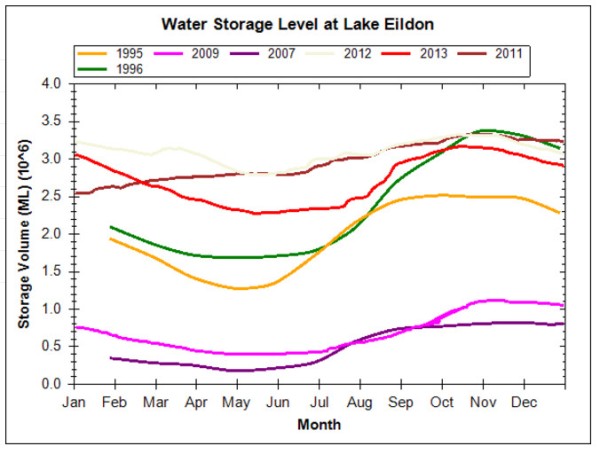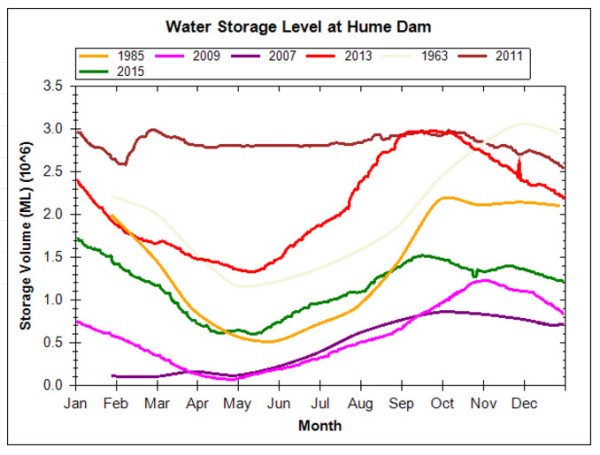On Friday June 3rd the Guardian presented some high quality images with the headline
Droughts, floods, forest fires and melting poles – climate change is impacting Earth like never before. From the Australia to Greenland, Ashley Cooper’s work spans 13 years and over 30 countries. This selection, taken from his new book, shows a changing landscape, scarred by pollution and natural disasters – but there is hope too, with the steady rise of renewable energy.
The purpose is to convince people that human-caused climate change is happening now, to bolster support for climate mitigation policies. But the real stories of what the pictures show is quite different. I will start with three images relating to drought in Australia.
Image 5
Forest ghosts: Lake Eildon in Victoria, Australia was built in the 1950’s to provide irrigation water, but the last time it was full was in 1995. The day the shot was taken it was at 29% capacity with levels down around 75ft.
Data from Lake Eildon (which is accessible with a simple search of Lake Eildon capacity) links to a graph where up to 7 years of data can be compared.

In 1995 the dam was not at full capacity, but it was full, for a short period, in the following year. However, more recently after the recent drought broke, in 2011 the reservoir was pretty much full for all the year.
But were the low levels due to more extreme drought brought on by climate change? That is very difficult to determine, as Lake Eildon is an artificial lake, constructed to provide water for irrigation occasional hydro-electric power as well as recreational facilities. The near empty levels at the end of the biggest drought in many decades could be just due a failure to predict the duration of the drought, or simply a policy of supplying irrigation water for the maximum length of time. The fact that water levels never reached full capacity for many years is indicated by a 2003 article in The Age
The dam wall at Lake Eildon, Victoria’s biggest state-run water storage, has been declared unsafe and will need a $30 million upgrade if the lake is to be refilled.
The dam, which is at its lowest level since being completed in 1956, will be restricted to just 65 per cent capacity because it no longer meets safety standards for earthquakes and extreme floods.
Image 6
Forest destroyed by bush fires near Michelago, New South Wales, Australia.
The inference is that this is caused by global warming.
According to Munich Re
The majority of bushfires in southeast Australia are caused by human activity
Bushfire is the only natural hazard in which humans have a direct influence on the hazard situation. The majority of bushfires near populated areas are the consequence of human activity. Lightning causes the smaller portion naturally. Sometimes, a carelessly discarded cigarette or a glass shard, which can focus the sun’s rays is all it takes to start a fire. Heat from motors or engines, or electric sparks from power lines and machines can ignite dry grass. Besides this accidental causes, a significant share of wildfires are started deliberately.
Humans also change the natural fire frequency and intensity. They decrease the natural fire frequency due to deliberate fire suppression near populated areas. If there is no fuel-reduction burning in forests for the purposes of fire prevention, large quantities of combustible material can accumulate at ground level.
Surface fires in these areas can become so intense due to the large amounts of fuel that they spread to the crowns of the trees and rapidly grow into a major fire. If humans had not intervened in the natural bushfire regime, more frequent low-intensity fires would have consumed the forest undergrowth and ensured that woodland grasses and scrubs do not proliferate excessively.
David Evans expands on the issue of fuel load in a 2013 article.
Like with the water levels in an artificial lake, forest fires are strongly influenced by the management of those forests. Extinguishing forest fires before they have run their natural course results in bigger and more intense fires at a later date. More frequent or intense droughts would not change this primary cause of many horrific forest fire disasters seen in recent years.
Image 7
Where has all the water gone?: Lake Hume is the largest reservoir in Australia and was set up to provide irrigation water for farms further down the Murray Basin and drinking water for Adelaide. On the day this photograph was taken it was at 19.6% capacity. By the end of the summer of 2009 it dropped to 2.1 % capacity. Such impacts of the drought are likely to worsen as a result of climate change. The last time the water was anywhere near this road bridge was 10 years ago, rendering this no fishing sign, somewhat redundant.
Again this is old data. Like for Lake Eildon, it is easy to construct graphs.

Following the end of the drought, the reservoir came back to full capacity. Worsening drought is only apparent to those who look over a short time range.
When looking at drought in Australia, Dorothea Mackellar’s 1908 poem “My Country” provides some context. Written for a British audience, the poem begins
I love a sunburnt country,
A land of sweeping plains,
Of ragged mountain ranges,
Of droughts and flooding rains
To understand the difference that human-caused climate change is having on the climate first requires an understanding of natural climatic variation over multiple time-scales. It then requires an understanding of how other human factors are influencing the environment, both intended and unintended.
Kevin Marshall









